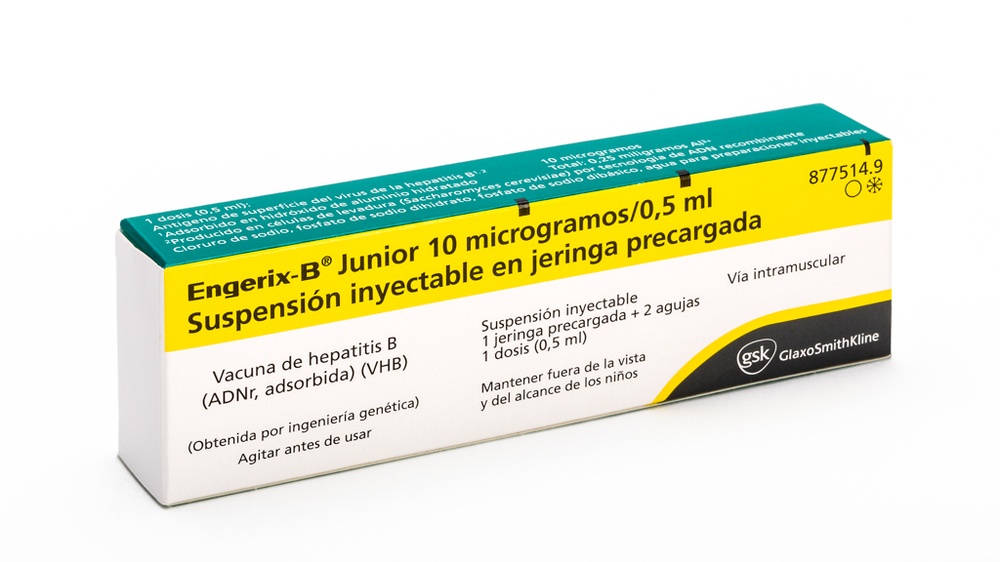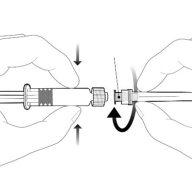

ЭНГЕРИКС-B ДЖУНИОР 10 микрограмм/0,5 мл, СУСПЕНЗИЯ ДЛЯ ИНЪЕКЦИЙ В ПРЕДНАПОЛНЕННОМ ШПРИЦЕ

Спросите врача о рецепте на ЭНГЕРИКС-B ДЖУНИОР 10 микрограмм/0,5 мл, СУСПЕНЗИЯ ДЛЯ ИНЪЕКЦИЙ В ПРЕДНАПОЛНЕННОМ ШПРИЦЕ

Инструкция по применению ЭНГЕРИКС-B ДЖУНИОР 10 микрограмм/0,5 мл, СУСПЕНЗИЯ ДЛЯ ИНЪЕКЦИЙ В ПРЕДНАПОЛНЕННОМ ШПРИЦЕ
Введение
Прошпект: информация для пользователя
Энгерикс-Б Джуниор 10 микрограмм/0,5 мл суспензия для инъекций в предварительно заполненном шприце
Вакцина против гепатита Б (АДНр, адсорбированная) (ВГБ)
Прочитайте весь прошпект внимательно перед тем, как вы/ваш ребенок начнете получать эту вакцину, поскольку он содержит важную информацию для вас.
- Сохраните этот прошпект, поскольку вам может потребоваться перечитать его.
- Если у вас есть какие-либо вопросы, проконсультируйтесь с вашим врачом или фармацевтом.
- Эта вакцина была назначена только вам/вашему ребенку, и не следует давать ее другим людям.
- Если вы испытываете побочные эффекты, проконсультируйтесь с вашим врачом или фармацевтом, даже если это побочные эффекты, которые не указаны в этом прошпекте. См. раздел 4.
На протяжении всего этого прошпекта любая ссылка на «вы» также может означать «ваш ребенок».
Содержание прошпекта
- Что такое Энгерикс-Б Джуниор и для чего он используется
- Что вам нужно знать перед тем, как вы получите Энгерикс-Б Джуниор
- Как вводится Энгерикс-Б Джуниор
- Возможные побочные эффекты
- Хранение Энгерикс-Б Джуниор
- Содержание упаковки и дополнительная информация
1. Что такое Энгерикс-Б Джуниор и для чего он используется
Энгерикс-Б Джуниор - это вакцина, которая используется для защиты от инфекции гепатита Б. Она также может помочь защитить от инфекции гепатита Д.
Эта вакцина может быть введена новорожденным, детям и подросткам до 15 лет включительно.
Гепатит Б - это инфекционное заболевание печени, вызываемое вирусом. Некоторые люди имеют вирус гепатита Б в своем организме, но не могут его устранить. Эти люди могут продолжать заражать других и известны как носители. Распространение заболевания происходит, когда вирус попадает в организм после контакта с биологическими жидкостями, почти всегда кровью, инфицированного человека.
Если мать является носителем вируса, она может передать вирус своему ребенку во время родов. Кроме того, возможно заразиться вирусом от носителя, например, при незащищенном сексе, совместном использовании шприцев или лечении с помощью медицинского оборудования, которое не было должным образом стерилизовано.
Основные признаки заболевания включают: головную боль, температуру, недомогание (тошноту) и желтуху (кожа и глаза приобретают желтый цвет), хотя примерно у трех из десяти пациентов нет признаков заболевания. Из этих инфицированных гепатитом Б один из десяти взрослых и до девяти из десяти детей становятся носителями вируса и, вероятно, разовьют тяжелые повреждения печени и в некоторых случаях рак печени.
Как работает Энгерикс-Б Джуниор
Энгерикс-Б Джуниор содержит небольшое количество внешней оболочки вируса гепатита Б. Эта внешняя оболочка не является инфекционной и не может вызвать заболевание.
- Когда вводится вакцина, она активирует иммунную систему организма для подготовки к защите от этих вирусов в будущем.
- Энгерикс-Б Джуниор не защитит вас, если вы уже заразились вирусом гепатита Б.
- Энгерикс-Б Джуниор может помочь защитить вас только от инфекции вируса гепатита Б.
2. Что вам нужно знать перед тем, как вы получите Энгерикс-Б Джуниор
Не следует вводить Энгерикс-Б Джуниор:
- Если вы аллергичны (гиперчувствительны) к Энгерикс-Б Джуниор или к любому другому компоненту этой вакцины (указанному в разделе 6).
- Если у вас есть температура (высокая температура тела).
Энгерикс-Б Джуниор не должен вводиться, если любая из этих ситуаций относится к вам. Если вы не уверены, проконсультируйтесь с вашим врачом или фармацевтом перед получением Энгерикс-Б Джуниор. Сообщите вашему врачу или фармацевту, если у вас есть аллергия или если у вас были проблемы со здоровьем после получения вакцины.
Предостережения и меры предосторожности
Проконсультируйтесь с вашим врачом или фармацевтом перед получением Энгерикс-Б Джуниор, если:
- Вы проходите диализ из-за проблем с почками или если у вас есть заболевание, которое может повлиять на вашу иммунную систему.
Люди, которым требуется диализ, у которых есть хронические проблемы с печенью, которые являются носителями гепатита С или которые являются ВИЧ-позитивными, также могут получать Энгерикс-Б Джуниор. Это связано с тем, что инфекции гепатита Б могут быть тяжелыми у этих пациентов. Вы найдете более подробную информацию о проблемах с почками и диализе в разделе 3.
Если вы не уверены, относится ли какая-либо из этих ситуаций к вам, проконсультируйтесь с вашим врачом перед получением Энгерикс-Б Джуниор.
До или после любой инъекции может произойти обморок (особенно у подростков), поэтому сообщите вашему врачу или медсестре, если вы обморокали ранее после введения инъекции.
Как и другие вакцины, Энгерикс-Б Джуниор может не полностью защитить вас от гепатита Б. Набор факторов, таких как возраст, пол, избыточный вес, курение и некоторые хронические проблемы, снижают иммунный ответ на вакцину. Если что-либо из этого относится к вам, ваш врач может решить провести анализ крови или ввести дополнительные дозы Энгерикс-Б Джуниор, чтобы убедиться, что вы защищены.
Использование Энгерикс-Б Джуниор с другими лекарствами
Сообщите вашему врачу или фармацевту, если вы используете, недавно использовали или можете использовать любое другое лекарство.
Энгерикс-Б Джуниор можно вводить одновременно с большинством обычных вакцин. Ваш врач обеспечит введение вакцин отдельно и в разных местах тела.
Беременность и лактация
- Если вы беременны или кормите грудью, считаете, что можете быть беременной или планируете стать беременной, проконсультируйтесь с вашим врачом или фармацевтом перед использованием этого лекарства.
Вождение и использование машин
Маловероятно, что Энгерикс-Б Джуниор повлияет на вашу способность управлять транспортными средствами или использовать машины. Однако не управляйте транспортными средствами или не используйте машины, если вы чувствуете себя плохо.
Энгерикс-Б Джуниор содержит натрий
Это лекарство содержит менее 23 мг (1 ммоль) натрия на дозу, поэтому оно считается практически «без натрия».
3. Как вводится Энгерикс-Б Джуниор
Как вводится ваша вакцина
Ваш врач введет рекомендуемую дозу Энгерикс-Б Джуниор.
Энгерикс-Б Джуниор будет введен:
- в виде инъекции в мышцу верхней части руки у детей и подростков
- в виде инъекции в бедро у новорожденных и маленьких детей
- в виде инъекции под кожу, если у вас легко образуются синяки или если у вас есть проблемы с свертываемостью крови.
Какая доза вводится
Вам будет введена серия инъекций Энгерикс-Б Джуниор. Как только вы завершите курс инъекций, вы можете ожидать долгосрочную защиту от гепатита Б.
- Новорожденные, дети и подростки до 15 лет включительно обычно получают вакцину в дозе 10 микрограмм/0,5 мл.
Существуют различные альтернативы введения Энгерикс-Б Джуниор. Ваш врач выберет наиболее подходящий график для вас.
Схема 1 – для новорожденных, детей и подростков до 15 лет включительно
Первая инъекция - сейчас
Вторая инъекция - через 1 месяц после первой инъекции
Третья инъекция - через 6 месяцев после первой инъекции
Схема 2 – для новорожденных, детей и подростков до 15 лет включительно
Первая инъекция - сейчас
Вторая инъекция - через 1 месяц после первой инъекции
Третья инъекция - через 2 месяца после первой инъекции
Четвертая инъекция - через 12 месяцев после первой инъекции
- У новорожденных схема 2 позволяет вводить Энгерикс-Б Джуниор одновременно с другими обычными вакцинами для детей.
- Эта схема также может быть использована в случае, если вакцинация проводится из-за недавнего контакта с гепатитом Б, поскольку она обеспечит более быструю защиту.
Очень важно, чтобы вы получали инъекции с рекомендуемой периодичностью. Если у вас есть какие-либо вопросы о дозе вакцины, которую вы получите, проконсультируйтесь с вашим врачом.
Вакцинация и роды
Если у вас гепатит Б и вы только что родили, может быть использована схема 1 или 2 для вакцинации вашего ребенка.
- Ваш врач также решит, вводить ли вашему ребенку иммуноглобулины против гепатита Б (человеческие антитела) во время первой инъекции. Это поможет защитить вашего ребенка от гепатита Б. Они будут введены в другое место инъекции.
Проблемы с почками и диализ
Если у вашего ребенка есть проблемы с почками или он проходит диализ, ваш врач может решить провести анализ крови или ввести дополнительные дозы вакцины, чтобы убедиться, что ваш ребенок защищен.
4. Возможные побочные эффекты
Как и все вакцины, эта вакцина может вызывать побочные эффекты, хотя не все люди испытывают их. Следующие побочные эффекты могут возникнуть при использовании этой вакцины:
Аллергические реакции
Если у вас возникает аллергическая реакция, немедленно обратитесь к врачу. Признаки могут включать:
- отек лица
- низкое кровяное давление
- затрудненное дыхание
- кожа становится синей
- потеря сознания.
Обычно эти признаки начинаются сразу после введения инъекции. Обратитесь к врачу немедленно, если они возникают после ухода из кабинета.
Другие побочные эффекты включают:
Очень часто(это может возникнуть у более 1 из 10 человек, получающих вакцину): головная боль, боль и покраснение в месте инъекции, чувство усталости, раздражительность.
Часто(это может возникнуть у до 1 из 10 человек, получающих вакцину): онемение, тошнота или рвота, диарея или боль в животе, потеря аппетита, температура (высокая температура тела), чувство общего недомогания, отек в месте инъекции, реакции в месте инъекции, такие как уплотнение.
Не часто(это может возникнуть у до 1 из 100 человек, получающих вакцину): головокружение, боль в мышцах, симптомы, подобные гриппу.
Редко(это может возникнуть у до 1 из 1000 человек, получающих вакцину): увеличение лимфатических узлов, сыпь, зуд, боль в суставах, онемение.
Побочные эффекты, сообщенные во время продажи Энгерикс-Б Джуниор, являются: легкая склонность к образованию синяков и неспособность остановить кровотечение, если произошел разрез, низкое кровяное давление, воспаление кровеносных сосудов, внезапный отек лица вокруг рта и горла (ангионевротический отек), неспособность двигать мышцами (паралич), воспаление нервов (неврит), которое может вызвать потерю чувствительности или онемение, включая временное воспаление нервов, вызывающее боль, слабость и паралич в конечностях и часто прогрессирующее до груди и лица (синдром Гийена-Барре), заболевание нервов глаза (неврит глаза) и рассеянный склероз, проблемы с движением рук или ног (невропатия), воспаление мозга (энцефалит), дегенеративное заболевание мозга (энцефалопатия), инфекция вокруг мозга (менингит), судороги, потеря чувствительности кожи к боли или прикосновению (гипоестезия), пятна фиолетового или красно-фиолетового цвета на коже (лихен планус), красные или фиолетовые точки на коже, боль и скованность в суставах (артрит), слабость мышц.
У очень недоношенных детей (на 28-й неделе беременности или ранее) периоды между дыханиями могут быть длиннее нормы в течение 2-3 дней после вакцинации.
Сообщение о побочных эффектах
Если вы испытываете любой побочный эффект, проконсультируйтесь с вашим врачом или фармацевтом, даже если это побочные эффекты, которые не указаны в этом прошпекте. Вы также можете сообщить о них напрямую через систему мониторинга безопасности лекарств. Сообщая о побочных эффектах, вы можете помочь предоставить больше информации о безопасности этого лекарства.
5. Хранение Энгерикс-Б Джуниор
- Храните эту вакцину вне поля зрения и досягаемости детей.
- Не используйте эту вакцину после даты истечения срока годности, указанной на этикетке и упаковке, после «CAD». Дата истечения срока годности - последний день месяца, указанного.
- Храните в холодильнике (при температуре от 2 до 8 градусов Цельсия).
- Не замораживайте.
- Храните в оригинальной упаковке, чтобы защитить от света.
- Лекарства не должны выбрасываться в канализацию или мусор. Утилизируйте упаковку и лекарства, которые вам больше не нужны, в пункте приема SIGRE в аптеке. Если у вас есть вопросы, проконсультируйтесь с вашим фармацевтом о том, как утилизировать упаковку и лекарства, которые вам больше не нужны. Таким образом, вы поможете защитить окружающую среду.
6. Содержание упаковки и дополнительная информация
Состав Энгерикс-Б Джуниор
- Активное вещество - внешняя оболочка вируса гепатита Б. Каждая доза содержит 10 микрограмм/0,5 мл белка, состоящего из этой внешней оболочки, адсорбированной на гидроксиде алюминия гидрате.
- Другие компоненты - хлорид натрия, дигидрат фосфата натрия, дибазический фосфат натрия и вода для инъекций.
Внешний вид продукта и содержание упаковки
Энгерикс-Б Джуниор - это белая мутная жидкость для инъекций.
Энгерикс-Б Джуниор (10 микрограмм/0,5 мл) выпускается в предварительно заполненном шприце с одной дозой с или без отдельных игл; размеры упаковки 1 и 10.
Возможно, не все размеры упаковок будут продаваться.
Владелец разрешения на продажу и производитель
Владелец разрешения на продажу
GlaxoSmithKline, S.A.
P.T.M. C/ Severo Ochoa, 2
28760 Tres Cantos (Мадрид)
Тел.: +34 900 202 700
Производитель
GlaxoSmithKline Biologicals s.a., Rue de l’Institut 89, B-1330 Rixensart, Бельгия
или
SmithKline Beecham, S.A., Carretera de Ajalvir. Km. 2,5.- 28806 Alcalá de Henares. Мадрид
Это лекарство разрешено в государствах-членах Европейского экономического пространства под следующими названиями:
Австрия, Дания, Финляндия, Исландия, Норвегия, Швеция: Энгерикс-Б
Бельгия, Люксембург: Энгерикс Б Джуниор
Франция, Ирландия, Италия: Энгерикс Б-10
Германия: Энгерикс-Б Дети
Греция: Энгерикс
Испания, Нидерланды: Энгерикс-Б Джуниор
Португалия: Энгерикс Б
Дата последнего обновления этого прошпекта:02/2024
Другие источники информации
Подробная и актуальная информация о этом лекарстве доступна на сайте Агентства по лекарствам и медицинским изделиям Испании (AEMPS) http://www.aemps.gob.es/.
---------------------------------------------------------------------------------------------------------------------------
Эта информация предназначена только для медицинских специалистов:
После хранения содержимое может представлять собой белый осадок с прозрачной бесцветной надосадочной жидкостью. После встряхивания вакцина слегка мутная.
Перед использованием вакцины необходимо визуально осмотреть ее на наличие посторонних частиц и/или аномального физического вида. Не вводите вакцину, если вы заметите любое из этих явлений.
Следует извлечь все содержимое однодозового шприца и использовать его сразу после извлечения.
Инструкции для предварительно заполненного шприца
| Держите шприц за корпус, а не за поршень. Отвинтите крышку шприца, повернув ее против часовой стрелки. |
| Чтобы вставить иглу, прикрепите основу к луэр-лок адаптеру и поверните ее на четверть оборота по часовой стрелке, пока не почувствуете защелку. Не вынимайте поршень из корпуса шприца. Если это произойдет, не вводите вакцину. |
Утилизация отходов
Утилизация неиспользованного лекарства и всех материалов, которые вступали в контакт с ним, должна осуществляться в соответствии с местными правилами.

Сколько стоит ЭНГЕРИКС-B ДЖУНИОР 10 микрограмм/0,5 мл, СУСПЕНЗИЯ ДЛЯ ИНЪЕКЦИЙ В ПРЕДНАПОЛНЕННОМ ШПРИЦЕ в Испании в 2025 году?
Средняя цена на ЭНГЕРИКС-B ДЖУНИОР 10 микрограмм/0,5 мл, СУСПЕНЗИЯ ДЛЯ ИНЪЕКЦИЙ В ПРЕДНАПОЛНЕННОМ ШПРИЦЕ в ноябрь, 2025 года составляет около 10.27 евро. Финальная стоимость может зависеть от региона, конкретной аптеки и рецептурного статуса. Для точной информации лучше проверить онлайн или в ближайшей аптеке.
- Страна регистрации
- Средняя цена в аптеках10.27 EUR
- Активное вещество
- Требуется рецептДа
- Производитель
- Информация носит справочный характер и не является медицинской рекомендацией. Перед приемом любых препаратов проконсультируйтесь с врачом. Oladoctor не несет ответственности за медицинские решения, принятые на основе этого контента.
- Аналоги ЭНГЕРИКС-B ДЖУНИОР 10 микрограмм/0,5 мл, СУСПЕНЗИЯ ДЛЯ ИНЪЕКЦИЙ В ПРЕДНАПОЛНЕННОМ ШПРИЦЕФорма выпуска: ИНЪЕКЦИОННЫЙ РАСТВОР, 20 мкг поверхностного антигена вируса гепатита B/млАктивное вещество: hepatitis B, purified antigenПроизводитель: Glaxosmithkline S.A.Требуется рецептФорма выпуска: ИНЪЕКЦИОННЫЙ РАСТВОР, 20 мкгАктивное вещество: hepatitis B, purified antigenПроизводитель: Glaxosmithkline BiologicalsТребуется рецептФорма выпуска: ИНЪЕКЦИОННЫЙ РАСТВОР, 20 мкгАктивное вещество: hepatitis B, purified antigenПроизводитель: Glaxosmithkline BiologicalsТребуется рецепт
Аналоги ЭНГЕРИКС-B ДЖУНИОР 10 микрограмм/0,5 мл, СУСПЕНЗИЯ ДЛЯ ИНЪЕКЦИЙ В ПРЕДНАПОЛНЕННОМ ШПРИЦЕ в других странах
Лучшие аналоги с тем же действующим веществом и терапевтическим эффектом.
Аналог ЭНГЕРИКС-B ДЖУНИОР 10 микрограмм/0,5 мл, СУСПЕНЗИЯ ДЛЯ ИНЪЕКЦИЙ В ПРЕДНАПОЛНЕННОМ ШПРИЦЕ в Польща
Аналог ЭНГЕРИКС-B ДЖУНИОР 10 микрограмм/0,5 мл, СУСПЕНЗИЯ ДЛЯ ИНЪЕКЦИЙ В ПРЕДНАПОЛНЕННОМ ШПРИЦЕ в Україна
Врачи онлайн по ЭНГЕРИКС-B ДЖУНИОР 10 микрограмм/0,5 мл, СУСПЕНЗИЯ ДЛЯ ИНЪЕКЦИЙ В ПРЕДНАПОЛНЕННОМ ШПРИЦЕ
Консультация по дозировке, побочным эффектам, взаимодействиям, противопоказаниям и продлению рецепта на ЭНГЕРИКС-B ДЖУНИОР 10 микрограмм/0,5 мл, СУСПЕНЗИЯ ДЛЯ ИНЪЕКЦИЙ В ПРЕДНАПОЛНЕННОМ ШПРИЦЕ – по решению врача и с учетом местных правил.





















